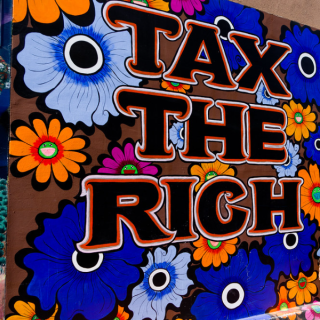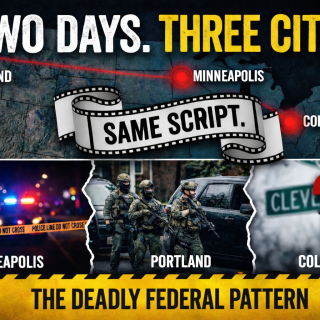The present moment—2022-2023 or more broadly the last 4 to 6 years—marks an unprecedented period in American history. But not for the usually repeated reasons. None of the major factors is fundamentally novel. The challenge and the significance of our times lay in the conjunction of a number of elements. Together they make a unique challenge. This is not what journalists, politicians, or on-air “experts” regurgitate.
In my historian’s alternative construction, I do see our times as unprecedented but as a result of complicated, contradictory relationships. On one hand, almost none of the major elements factors are essentially new. On the other hand, the challenge to our understanding and strategic choices of responses lays in identifying and tracing the conjunction of a number of elements, larger and smaller, short- and long-term, that together uniquely challenge the American experiment and experience.
To make sense of the relationships of precedent and novelty, patterns of continuing development and rupture from the recognized past, we must accept complexity and contradiction. Simplification—the name of the game now--is a certain path to distortion and miscomprehension.
Open your newspaper, if your city or town still has one. Turn on network or cable news, or the radio including the once reliable NPR. Contradictory assertions that we live in “unprecedented times” overwhelm us. Few of the endless efforts present relevant context or comparisons.
The pronouncements are frequently contradictory. Within one paragraph, we are simultaneously in uncharted territory and on the verge of another Civil War. Or we face fascism but without Hitler, National Socialism, or the political economy of Germany in the 1920s. Then we confront unprecedented inflation, and at the same time declining unemployment and rates of leaving the workforce, all based on non-comparable data and only within 20 or 40 years. The repetitive claims ring in self-caricature.
Examples are too many to cite. They appear on the front as well as the opinion pages of the New York Times and Washington Post. The recent neo-conservative rendition of The Atlantic is one exemplar, from Eastern Europe to the United States. The Wall Street Journal, New York Post, and Fox News all play their own claims-games.
What is unprecedented today is first the effectiveness of a highly organized, well-funded right-wing social-media savvy campaign. It is funded to an unprecedented degree by under-the-cover “soft money” from billionaires. Inextricably interrelated is the loudly effective, high volume echo chamber across electronic media of all kinds.
As a comparative social historian, I take offense at the ahistorical, dramatically simplified framing of either or both precedentedness or lack of precedents. “Precedent” is itself a historical judgement, a matter of both context and interpretation. It requires careful comparisons and is open to questioning. The “power of precedent” is a legal concept much more than a philosophical guide. Understanding contemporary outcomes is challenging and full of conflicts and contradictions.
Today’s common claims are rhetorical, metaphorical, sometimes analogical of politics and/or twenty-first century opinion writing that replaces sound journalistic practice. They are more ideological than empirical.
Take one major broad theme that dramatically reflects the intertwining long- and short-term factors: racism, fear and easily manipulated grievances, and the struggle for equality versus preservation of white superiority and segregation. It is inseparable from almost all major factors. None of this is novel.
First, despite the fabrications of the 1620, 1776, or Texas’ 1836 alternative US history “projects,” it is easy to trace the contours of race and racism from 1619 and earlier. The right-wing denial of the significance of 1619 is only one certain sign; so too is the assertion that slavery is irrelevant to causes and conduct of the American Revolution, formation of the Union, or Constitution (despite the 3/5s clause or the dual-chamber legislature).
Second is a an accelerating line of reinforcing causal connections from President Truman’s integration of the armed forces and arming of Black soldiers after World War II through the 1954 Brown v. Board of Education “separate is not equal” ruling; the often violence-prone civil rights and integration struggles of the 1960s and continuing: the 1964 Voting Rights and 1965 Civil Rights legislation, massive public and private efforts to maintain school and neighborhood segregation, whose academic study became known as the three big, easily manipulatable scare words: Critical/Race/Theory.
Through the 1960s to the present, in ebbs and flows, with changes in partisan dominance at local, state, and federal levels, formerly restricted public monies are transferred to fund private schooling; charter and segregation academies—increasingly for profit and quasi- or illegal—bloom; inner-city schools decline or close; red-lining takes increasingly varied forms. Affirmative action and equal opportunity programs are occasionally misapplied but much more often misrepresented, now at the US Supreme Court. They become unnecessarily divisive. Not coincidentally, at the same time, an endless variety of legal and extra-legal efforts to maintain white power are attempted.
Reductions in funding for public social services and schools, as opposed to private sectors, accompany shifts in job opportunities from “blue” to “white collar” with increasing prerequisites. The very real social, economic, and political gains of Blacks, Latinos, Asians, women, and others compete in dialectical struggle with counter forces. We seldom appreciate the complexity of these currents as we rush toward linear, contradictory narratives of one group “rising” and others “falling.” Past or present life is never a zero sum game.
That complex process continued from the end of World War II until the 1990s but especially the 2010s, through Nixon, Carter, Reagan, Bush One, and Clinton. Scales began to shift between the economic downturns of the 1990s and 2000s and the rise of Newt Gingrich’s right wing, states’ “rights,” and racist power grabs in Congress, and their widespread ripples and political shifts in many states.
The national trauma of Bush Two v. Gore, Bush’s two terms, the fright after 9/11, and the intensely racist response to the popular election of the US’s first Black president in 232 years all contributed to the “rise” of the incoherent and policy-less Tea Party.
So did the decline of newspapers and broadcast news and the “rise” of the unregulated internet and social media. 9/11 added new insecurity and xenophobic anti-Muslim and rising anti-Asian hate, rhetorically and physically. Along with the overwhelmingly and easily manipulated sexist response to the first female candidate for president of the US in 2016, those elements together created the probability of the improbable: the election of Donald J. Trump with a minority of the popular vote.
A creation of the media, and grift and corruption, Trump is the most polarizing, dishonest politician in modern America. His “America First” never took the form of a platform and often translated into “America Last” in practice. It stands as a new low in the long history of failed leadership by sloganeering.
Over these decades, the established meanings of both liberal and conservative are lost. Politicians and the media decided for reasons of simplicity, facile comparison, and historical ignorance that “liberals” and “moderates” are now an undefined but potentially extreme “left,” and that self-described “progressives” (who have little clear relationship to Progressives of the early twentieth century) are “far” or “extreme left” or “socialist.”
For their part, conservatives largely lost their historical foundations in values and doctrines of conservativism developed over centuries. Most are now inseparable from “right-wing radicals,” “militants,” or “ideologues. Long-accepted terms and maxims lost their meaning.
In history, theory, and tradition, conservatives believe in facts, accept debate, and are more or less tolerant if not egalitarian. Especially importantly, they believe in limited government, not banning by legislation, dictate, or judicial ruling anything with which they disagree regardless of their lack of knowledge about it.
This is remarkably true and unprecedented historically with respect to banning “critical race theory;” complete, inclusive, or “divisive” history; and a bewildering array of published books that are almost never actually read by the banners. The objects of attack are almost always written by women, minorities, and the differently gendered.
What is unprecedented today, most glaringly since 2020, but growing from the 1990s, is first the effectiveness of a highly organized, well-funded right-wing social-media savvy campaign, funded by the Koch Brothers, Heritage PAC, Bradley Foundation, and Robert Gates. This is amplified by ALEC (American Legislative Exchange Council); with admittedly dishonest and fabricated statements by fake journalists like Christopher Rufo, and right-wing professors, lawyers, and politicians.
It is trumpeted by Number 45 and right-wing congressional representatives—for fun and profit, occasionally for electoral support. And it is broadcast to millions of viewers—but still a distinct minority--by Sean Hannity and Tucker Carlson on Fox News, and spread like an infection by OANN, Wall Street Journal, New York Post, Washington Times, USA Today, and right-wing opinion writers in New York Times, Washington Post, and recently The Atlantic and Harpers.
Together, they achieve an unprecedented and, for an active, fearful minority of the population, very successful nationwide mis- and dis-information campaign. It is rooted in lies, distortions, false equivalencies, and illogic, all taken out of context. Neither the media, nor scholars or other “experts” actively and factually refute them. The Democratic Party almost completely fails to respond effectively. The right-wing campaign is rooted fundamentally in fear and grievance, sometimes real but much more often exaggerated, distorted, and exaggerated.
Accompanying these campaigns is the Republican recognition that their minority political power depends on imperatives for voter suppression inside and outside the law. This intersects with the exaggerated promotion of census trends that the white population will shortly be a minority population. This is not unprecedented.
In my historian’s view, the power and impact of these efforts exceeds the extent and influence of the Hearst "yellow press" of the earlier twentieth century, or more recently, the manipulated mainstream media-enforced pro-Vietnam war consensus. Partly in response, genuinely alternative media—primarily in print—developed. The twenty-first century awaits the latter.
Put into a wider, fact-based historical context, many—perhaps most, if we can extrapolate from a range of opinion polls--Americans would celebrate our uneven present moment as the gradual achievement of the “American dream” or dreams; “promise” or promises, incomplete as they may be.
The inseparable decline and failure of public and private education at all levels and journalism in the past three or more decades amplify rather than correct or at least clarify often wild, fact-free claims. Among many elements, I draw attention to history and civics education on one hand, and the shift from news reporting to opinion writing in the context of the financial collapse of local dailies and broadcast stations, and the rise of large national, for-profit anti-legitimate journalism chains.
Few Americans are prepared to and actively practice reading critically, and understand what they read, see, and hear in any meaningful context. Between education and the media, fact-checking and asking questions, even editing and copy-editing are lost practices. To me as a reader, especially infuriating is the practice of liberal and progressive journalists and even scholars, who should be expected to know better, to presume that if the right-wing swings to extremes, so too must the left. There is no need for evidence or examples. False equivalencies reign.
Into this increasingly volatile and unstable mix, the relative success of Trump’s and his Trumpists’ media- and fear-driven minority campaigns made headway, amplified by widespread disinformation efforts. The distortion of the results of the 2020 presidential election, Trump’s second loss in the popular vote, galvanized a small percentage but intensively active minority to attempt an insurrection, the first of its kind in US history.
In this context, the combined forces of unusual but not unprecedented, sharp ruptures of the states into red and blue, with red states more right wing than at any time since the real Civil War of the 1860s and Reconstruction; a closely divided Congress with limited ability to enact policy even when supported by substantial majorities of Americans; and most starkly a packed radical right-wing Supreme Court majority hell-bent on ignoring the US Constitution, case law, judicial conservatism, textualism, originalism, and history wreak havoc on our society, culture, and policy.
Of all these factors, the “rulings” of the Trump Supreme Court are seemingly the most unprecedented. But the anti-New Deal court of the early Franklin D. Roosevelt years (that he threatened to “pack”) provides a precedent.
The question of the moment: if we are truly at a tipping point, will we turn right or moderate to liberal? Time will tell. History never is predictive.
Related essays by Harvey J. Graff
“Civics tests should be required to hold public office,” Inside Higher Education, Oct. 21, 2021
“America First: An Excavation of Trumpism and the Trump Agenda,” Columbus Free Press, Oct 24, 2021; reprinted with new introduction May 7, 2022;
“Media misconceptions and the ten minute historical memory,” Busting Myths, Columbus Free Press, Dec. 29, 2021
“Know Nothings: A scholar and author examines the banning of books, past and present,” Publishers Weekly, Jan. 3, 2022//”Harvey J. Graff Examines the History of Book Banning,” Dec. 31, 2021 online
“Texas and Florida secede from reality; Ohio imitates,” Busting Myths, Columbus Free Press, Jan. 4, 2022
“The disappearance of journalistic standards in opinion essays as they replace the news,” Busting Myths, Columbus Free Press, Jan. 30, 2022
“How many “projects” does it take to obstruct a truly American history?” Busting Myths, Columbus Free Press, Feb. 16, 2022
“Battle of the books: A professor examines the 1619, 1620, 1776, and 1836 projects,” Publishers Weekly, Feb. 28, 2022/Online “Battle of the Books: When Historical Reassessments Collide: A professor examines the 1619, 1620, 1776, and 1836 projects,” Feb. 25, 2022
“Book Banning Past and Present,” Against the Current, 218 (May-June, 2022), 6-7
“The nondebate about critical race theory and our American moment: The interaction of past, present, and alternative futures,” special issue on Memory Laws or Gag Laws? Disinformation Meets Academic Freedom, Journal of Academic Freedom, Vol. 13, Fall, 2022)
------------------------------
Harvey J. Graff is Professor Emeritus of English and History at The Ohio State University and inaugural Ohio Eminent Scholar in Literacy Studies. Author of many books on social history, the history of literacy and education, and interdisciplinarity, he writes about the history and contemporary condition of higher education for Times Higher Education, Inside Higher Education, Academe Blog, Washington Monthly, Publishers Weekly, Against the Current; Columbus Free Press, and newspapers. Searching for Literacy: The Social and Intellectual Origins of Literacy Studies is published by Palgrave Macmillan in August. My Life with Literacy: The Continuing Education of a Historian. The Intersections of the Personal, the Political, the Academic, and Place is forthcoming. He thanks undergraduate friends, former students, and colleagues of all ages and orientations. He thanks Steven Weissman, Matthew Snyder, and David Finkel for constructive comments.



